With Burgundy en primeur coming to a close – and such a good array of 2018s to choose from at that – fine wine collectors might feel inclined to tighten their purse strings over the coming months (perhaps until the next big campaign to come – Bordeaux 2019 en primeur). For those unable to resist the temptation of continuing to grow their wine collection, the Rhône is a perfect resting place for high-quality drinking wines.
This week we focus on a subset of Rhône MUST BUYs – those under £100 per bottle in-bond (when bought by the case), with WL scores above 95, of which there are 36.
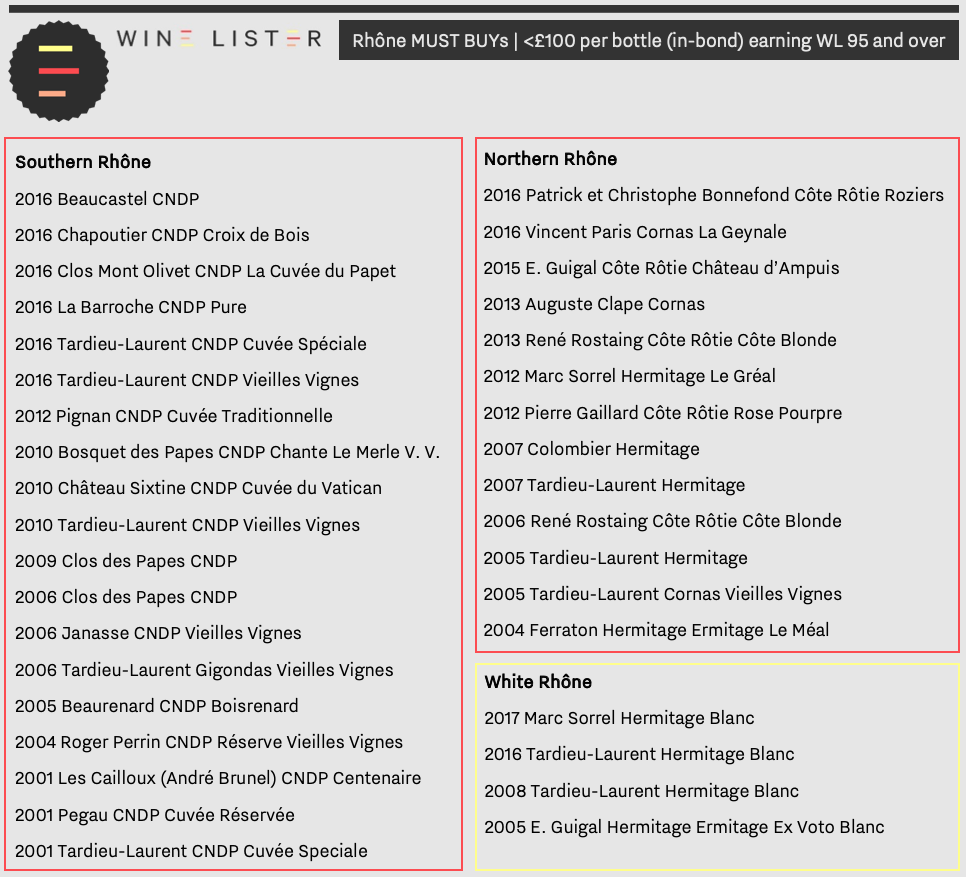
Châteauneuf-du-Pape wins the lion’s share of top Rhône MUST BUYs under £100, with 18 entries across eight different vintages. The exceptional 2016 vintage features heavily, however for wines drinking now, 2005 Beaurenard’s CNDP Boisrenard or 2009 Clos des Papes’ CNDP are particularly interesting options.
Hermitage too fairs well, with five reds and all four whites. Value Picks 2007 Colombier Hermitage and 2004 Ferraton Ermitage Le Méal provide impressive quality and bottle age for just £33 and £35 per bottle in-bond respectively (if you can get your hands on any).
Côte Rôtie matches in number for reds, and features Hidden Gem 2012 Côte Rôtie Rose Pourpre from Pierre Gaillard, which Wine Lister partner critic, Jancis Robinson, awards 18 points, commenting, “No doubt this is a very special cuvée”.
A consistent feature throughout is Maison Tardieu-Laurent – a powerhouse producer of reference for quality matched by exceptional value in the Rhône.
See the selection of Rhône MUST BUYs featured above here, or browse the full MUST BUY selection.
With Burgundy 2018 en primeur in full swing, soaring prices for some of Burgundy’s best can add to the January blues. While Burgundy prices tend to rise more quickly after release than any other region (making the en primeur buying system therefore extremely worthwhile), other regions provide better sources of good value wines for drinking, rather than cellaring for future consumption. To wave goodbye to any remaining blues as January come to a close, Wine Lister therefore looks this week at Value Picks from across fine wine regions.
Wine Lister’s Value Pick algorithm simply flags wines with the best quality-to-price ratios of all the wines in our database. A coefficient is applied to allow exceptional quality to be recognised, even for higher-priced wines.
The chart below shows the top nine regions for red Value Picks, and their average price per region.
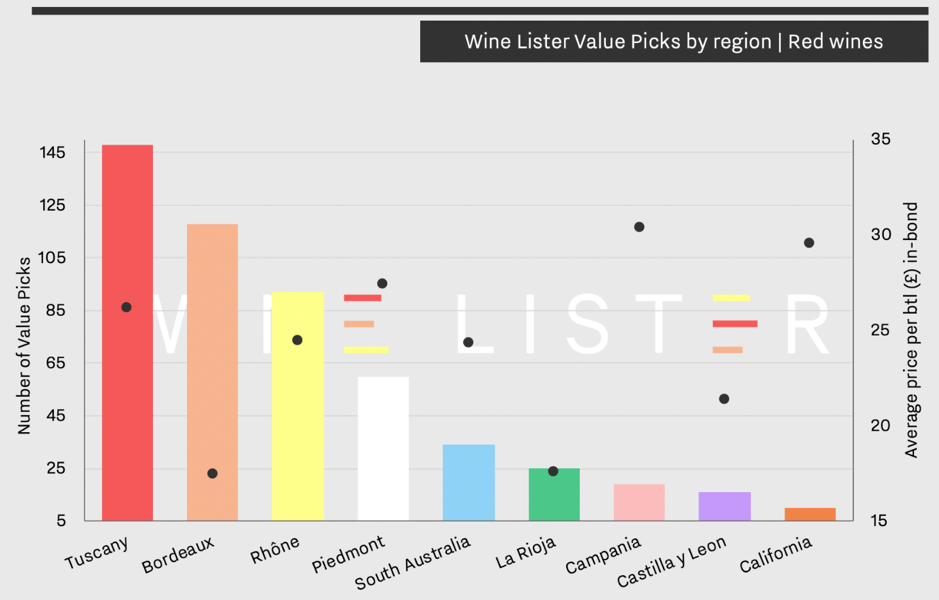
Italy takes the lead for number of best-value wines overall, with 227 Value Picks from across three regions – Tuscany, Piedmont, and Campania. Indeed, the top 10 Value Picks by WL score all hail from Tuscany, with wines such as Fontodi’s Chianti Classico Vigna del Sorbo Riserva, Isole e Olena’s Collezione Privata Syrah, and Castello dei Rampolla’s Sammarco making the cut.
Piedmont does not go wanting for Value Picks, with a wide range of suggestions, from Domenico Clerico’s Barolo Ciabot Mentin to Vietti’s Langhe Nebbiolo Perbacco.
France also does well for Value Picks, with 210 reds entries between Bordeaux and the Rhône. The former region has the lowest average price of all Value Pick regions shown above (£17.47 per bottle in-bond – when buying a full case), and includes Crus Classés from across appellations such as Malartic-Lagravière Rouge and Grand Mayne, as well as some second wines of Grands Crus châteaux (e.g. Pichon Comtesse’s Réserve de la Comtesse, and La Dame de Montrose).
The Rhône is home to 93 Value Picks from both north and south, and provides a list particularly strong in back vintages. Entries include Ferraton’s Hermitage Les Dionnières 2004, and Clusel Roch’s Côte Rôtie 2009.
The new world is well-represented by Value Picks from Australia across the McLaren Vale and Barossa Valley. California also makes an appearance, although perhaps expectedly, its 10 Value Picks earn the highest average price of any region shown in the chart above.
Search through all red Value Picks here.
Burgundy is, quite noticeably, missing from the top red Value Picks chart. It achieves just four in total: 2002 Joseph Drouhin Gevrey-Chambertin, 2003 Confuron-Cotetidot Echezeaux, 2017 Bertrand Ambroise Nuits-Saint-Georges, and 2007 Bouchard Volnay Clos des Chênes. However, Burgundy is much more present for whites – watch this space for white Value Picks later in the week.
For the last three consecutive updates, Burgundy has worn the crown for highest number of new MUST BUY entries. This week it shares its prime position with Tuscany, as the two regions hold six wines each of the 27 new MUST BUYs. Whilst previous updates have been geographically diverse, this week’s countries of focus are France and Italy only.
All but one of this week’s new Tuscan MUST BUYs can be considered “Super Tuscans”. Buzz Brands Querciabella and Sassicaia make the cut for their 2015 and 2007 respectively. Producer Fattoria La Massa earns another place this week for Giorgio Primo, making its 2016 the sixth MUST BUY vintage of this same wine. 2015 Percarlo from San Giusto a Rentennano and 2016 l’Apparita from Castello di Ama complete the new “Super Tuscans”. A second offering from Castello di Ama is this week’s only new Chianti Classico entry, and brings the producer’s MUST BUY total to eight, equalling Italy’s other top MUST BUY producers, Castello dei Rampolla, and Isole e Olena, in number.
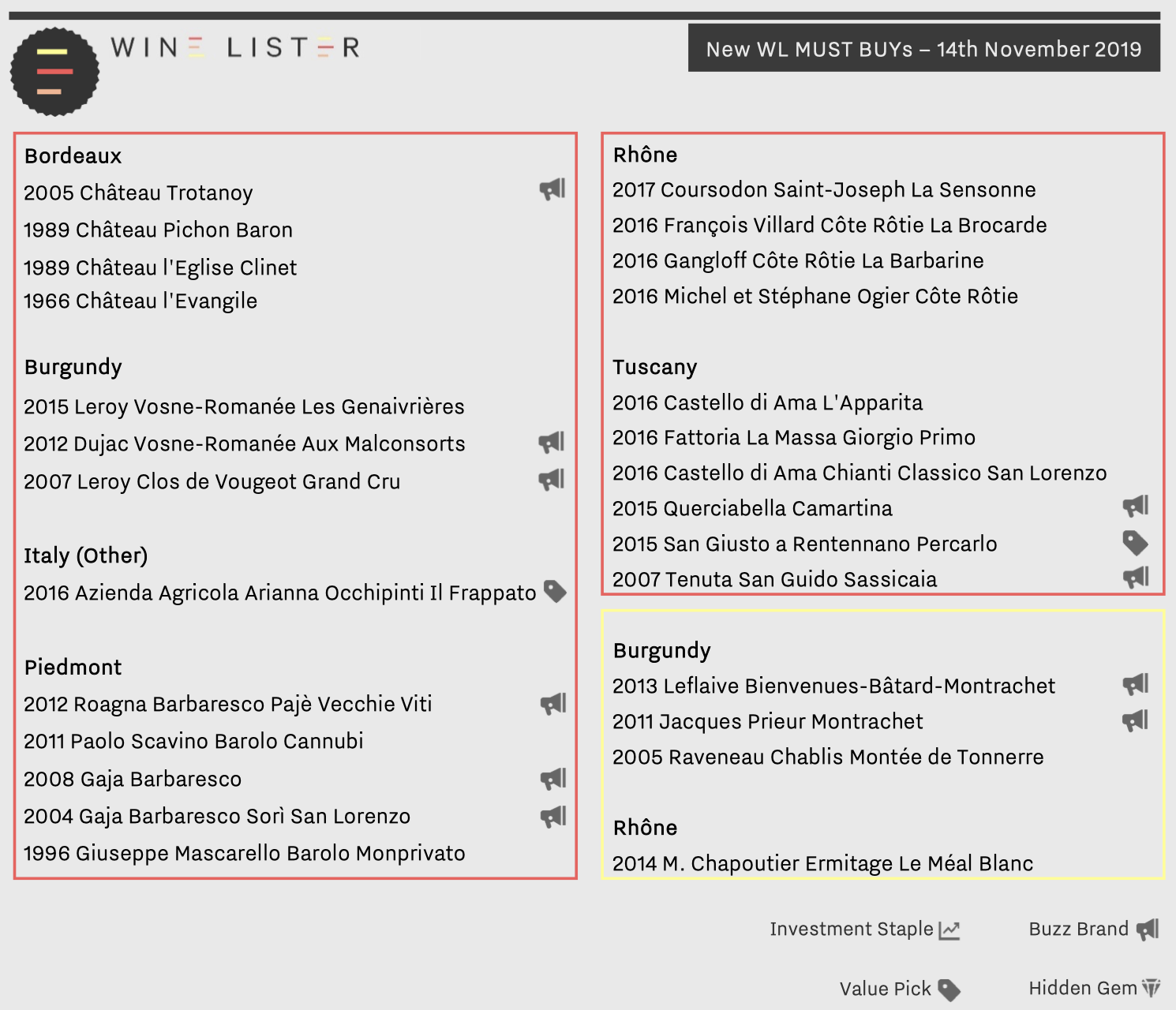
Further North in Italy, Piedmont is by no means overlooked, with Roagna and Paolo Scavino featuring on the new MUST BUY list for Barolo this week (in 2012 and 2011 vintages respectively), alongside Giuseppe Mascarello’s 1996 Barolo Monprivato. Gaja is represented twice, and completes the Piedmont five with the straight Barbaresco and the Sorì San Lorenzo.
France’s chief MUST BUY region, Burgundy, offers three reds and an equal number of whites, with Leroy representing two of the three Pinot Noirs (2015 Vosne-Romanée Les Genaivrières and 2007 Clos de Vougeot). Vosne-Romanée earns another mention through Dujac for its 2012 Aux Malconsorts. Domaine Leflaive, Jacques Prieur, and an older vintage of Raveneau take this week’s new white Burgundy MUST BUY places.
Outside Burgundy, France is also well-represented by the Rhône, with a 2017 from Coursodon, together with 2016s from François Villard, Gangloff, and Michel et Stéphane Ogier. Chapoutier’s 2014 Ermitage Le Méal Blanc completes the latest additions of MUST BUY whites. Older vintages of Bordeaux also make the cut, including a 1966 from l’Evangile, and one 1989 from each bank – l’Eglise Clinet and Pichon Baron.
To help keep track of the weekly updates, check out our latest tool on the search page to help you browse only the newest additions to the full MUST BUY list.
This week’s “top five” blog is a first for Wine Lister, as we analyse the highest-Quality wines of a single producer, Michel Chapoutier. Readers should note that this is simply an analysis exercise, and not a paid advertisement (albeit a shining review of Chapoutier, given how high the Quality scores are).
In first place of this week’s top five, perhaps surprisingly, is a white wine – Chapoutier’s Ermitage Blanc L’Ermite, with a Quality score of 966. Not only does this make it the highest-quality white Rhône on Wine Lister, but also the second highest-quality wine from the Northern Rhône overall, beaten only by Jean-Louis Chave’s Hermitage Cuvée Cathelin. The 2015 earns 94-96 points from Wine Lister partner critic, Vinous, with Josh Raynolds commenting on its “outstanding focus and persistence”. While outperforming its siblings for Quality, it also earns the highest average price of the group, at over £300 per bottle in-bond.
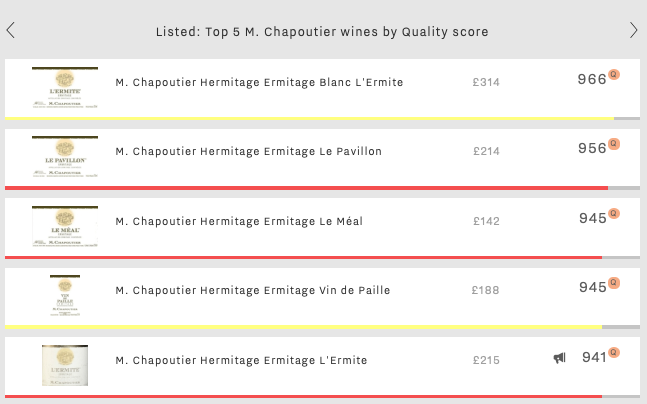
Next up is the first red of the group, Ermitage Le Pavillon, with a Quality score of 956. Wine Lister partner critic, Jancis Robinson, awards the 2016 vintage an impressive 19 points, naming it a “polished and pure Hermitage”. It also earns the group’s best Brand score of 897, appearing in 15% of the world’s best restaurants and ranking in 266th place for Wine-Searcher searches among the c.4,000+ wines on Wine Lister.
In joint-third place comes the second red of the group, Ermitage Le Méal, and Chapoutier’s sweet white, Ermitage Vin de Paille. Both achieve a Quality score of 945, however they are distinctive not just in their respective styles, but also in their Brand scores. Le Méal is clearly the better-known, with a Brand score of 724 and a search rank of 710, compared with the Vin de Paille’s Brand score of 593 (the lowest of this week’s top five), and a search rank of 2088. Interestingly however, the Vin de Paille’s presence in the world’s top restaurants is the better, if only by 1% (6% vs. 5% for Ermitage Le Méal).
Rounding out Chapoutier’s top five for Quality is the Ermitage L’Ermite, with a Quality score of 941. Despite its position at the bottom of the group, it achieves the highest Quality score at vintage level for the 2010 (992). The Ermitage L’Ermite 2010 achieves 95+ points from Wine Lister partner critic, Vinous, and though Josh Raynolds calls it “remarkably long, chewy, smoke- and spice-accented…”, he also warns it “should be stashed away and forgotten for a good long while”.
Price and price performance have been hot topics for Wine Lister’s recent blog posts across several regions (Burgundy, Champagne, Tuscany). The Rhône Valley flies further under the radar than these as a region for investment, perhaps in part because its two distinct vineyard areas – North and South – are too different to be cast under the same umbrella. This week’s top five examines the highest prices in the Northern Rhône.
In first place is Domaine Jean-Louis Chave’s Hermitage Cuvée Cathelin. With an average price of £5,248 (per bottle in-bond), it is almost 20 times more expensive than the average of the other four wines in this week’s group. The small quantity of wine, made only in the best years, combined with a Quality score of 977 – the best of this week’s top five – go some way to explaining the four-figure price tag. (Interestingly, the most expensive wine in the Southern Rhône, Buzz Brand Château Rayas’ Chateauneuf-du-Pape, costs an average of £478, or just 9% of the Cuvée Cathelin).
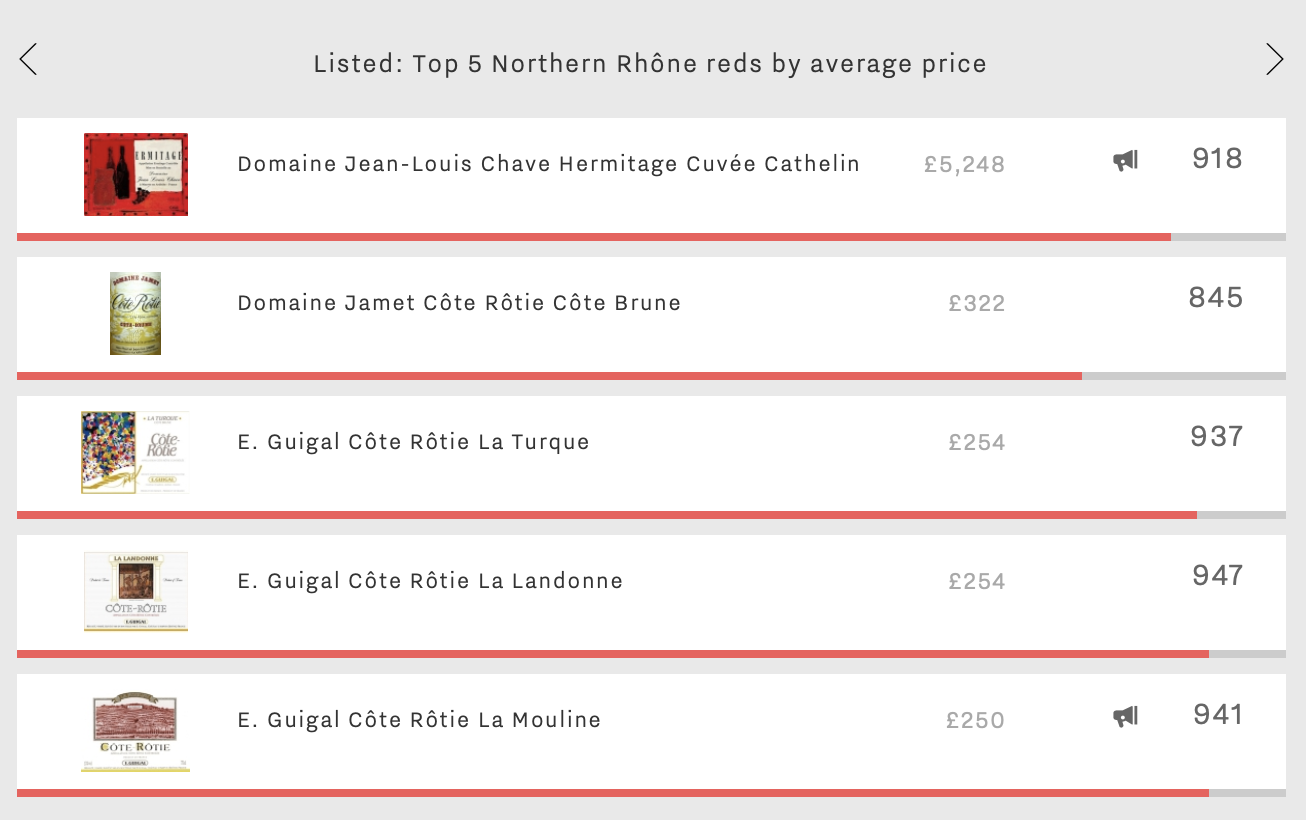
Back in the Northern Rhône, the next of this week’s top five is Domaine Jamet’s Côte Rôtie Côte Brune. Although £4,926 less expensive than this week’s number one, at £322 per bottle in-bond, it actually achieves the best three-year price performance, with a compound annual growth rate (CAGR) of 24.7%. With an average production volume of just 2,400 bottles per year, it is perhaps unsurprising that the wine’s Brand and Economics scores (at 763 and 759 respectively) are lower than its Quality score (946), as it appears in only 8% of the world’s best restaurants, and just three bottles were traded at auction internationally last year.
The remaining wines of this week’s top five hail from the same producer, Guigal, and come as a trio affectionately-known to the trade as “La-Las”. Though close together in price, it is interesting to see the subtle differences between these three Côte Rôtie across Wine Lister’s 13 score criteria.
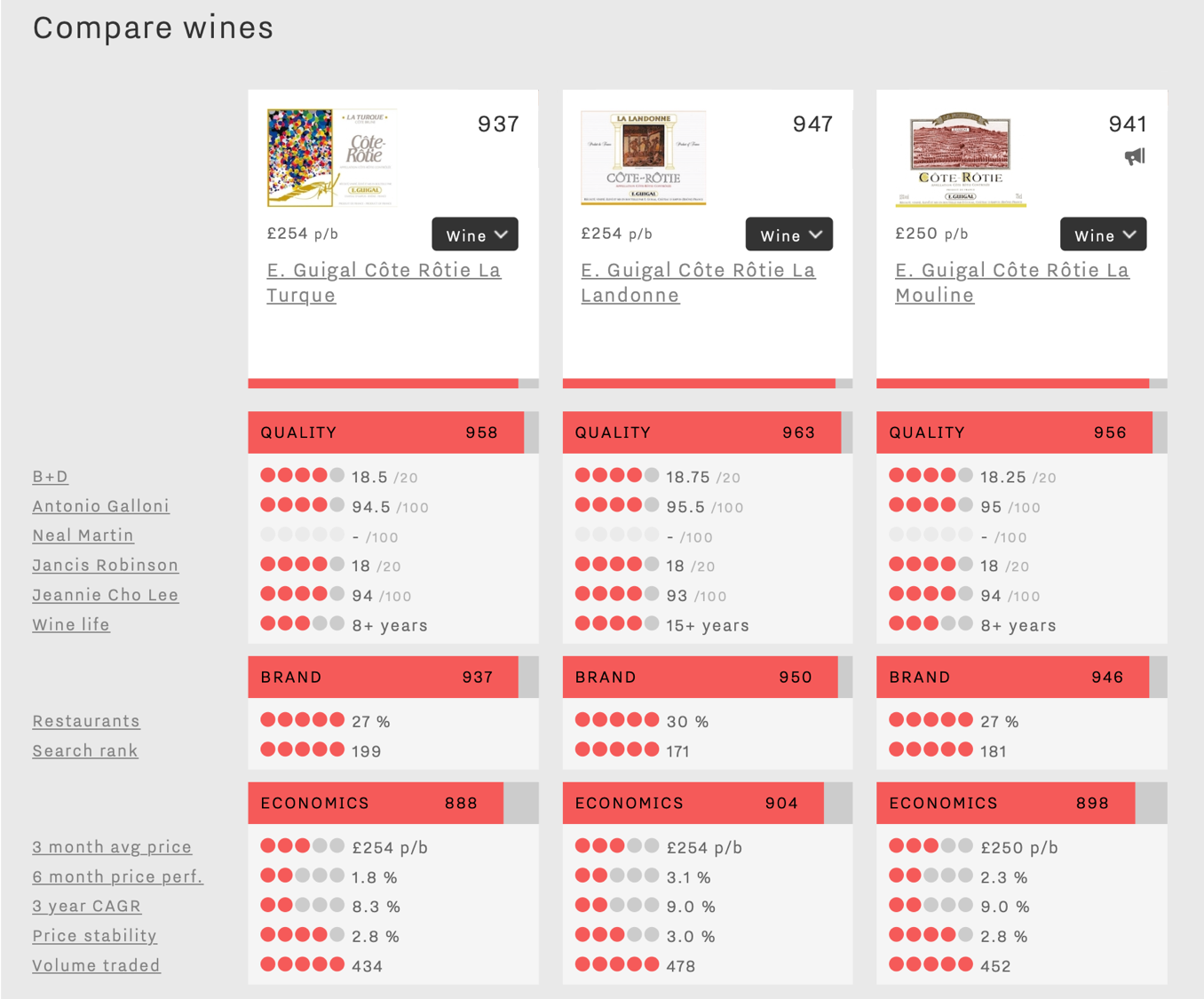
The chart above, created using Wine Lister’s Comparison tool, proves La Turque to be the lowest-scoring of the three overall. It shows slightly less demand with a lower search rank of 199 out of the c.4,000 wines on Wine Lister, whereas its siblings earn more monthly searches on Wine-Searcher. It also under-performs against the other two in economic terms, with lower long- and short-term price growth, and fewer bottles traded annually at auction.
By contrast, La Landonne achieves the top Quality score of 963 (and an average wine life just under twice that of its siblings), the best brand strength, and the highest average number of bottles traded annually at auction (478).
While La Mouline has the lowest average price of the three (£250 per bottle in-bond), it is the only one to earn Wine Lister’s Buzz Brand stamp, and achieves the joint-best three-year price performance with La Landonne – a CAGR of 9%.
‘Tis the season of dark evenings, woolly jumpers, and open fires. To round out the perfect winter evening, Wine Lister has many a drinking suggestion up our collective cashmere sleeves, but let us start with these top five 20-year-old Châteauneuf-du-Papes by Quality score.
Unsurprisingly, the Southern Rhône beats its Northern sibling for price to quality ratios, with the average Quality score of the top five 1998 Châteauneuf-du-Papes at 968, for an average in-bond price per bottle of £354. Comparatively, the Northern Rhône’s top five 1998 average Quality score is 959 for an eye-watering £882 per bottle.
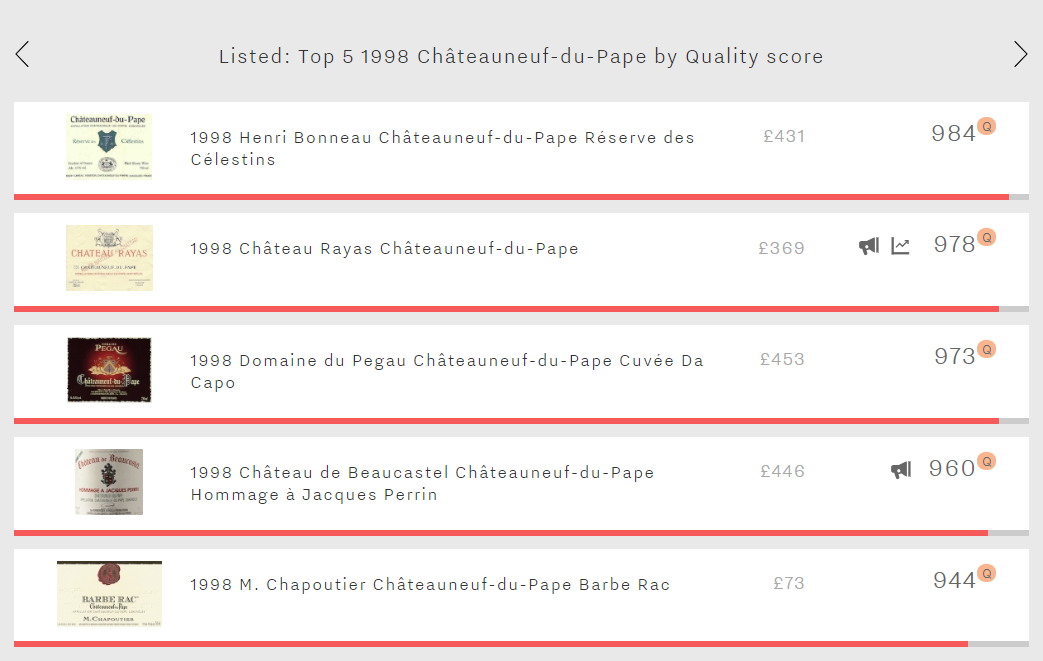
In first place of this week’s top five is Henri Bonneau’s Châteauneuf-du-Pape Réserve des Célestins. Its Quality score of 984 for the 1998 vintage is not only the best of this week’s top five, it is also Bonneau’s highest of the last 20 years, for £431 per bottle in-bond. This price tag is thanks to solid short- and long-term price performance, with six-month price growth of 16.9% and a three-year compound annual growth rate (CAGR) of 16.2%.
Next for 1998 Châteauneuf-du-Papes by Quality score comes this week’s best brand, Château Rayas. Its Brand score of 982 is thanks to presence in 33% of the world’s best restaurants, and an impressive search ranking as the 53rd most-searched-for wine on Wine Lister. Wine Lister partner critic Jancis Robinson awards it full marks, describing it as “not dissimilar” to Rousseau. Its impressive quality and popularity are complimented by the highest Economics score of this week’s top five (988) thanks to the top six-month price performance of 21.7% and a three-year CAGR of 25%.
In third place is Domaine du Pegau’s Cuvée Da Capo 1998 with a Quality score of 973. It is the most expensive of this week’s top five, at £453 in-bond per bottle, perhaps due to its cult-style following. The Cuvée Da Capo achieves the highest average trading volumes at auction of the group (408 bottles per year), according to The Wine Market Journal.
The fourth wine of this week’s top five may also be said to have somewhat of a cult following. Beaucastel’s Hommage à Jacques Perrin 1998 is priced at £446 per bottle in-bond for a Quality score of 960. Despite this excellent score, eight of its last 15 vintages have managed even better Quality scores than the 1998 – indeed Hommage à Jacques Perrin is on average the highest-scoring Châteauneuf-du-Pape on Wine Lister (with an average Quality score of 965).
Finally, M. Chapoutier’s Châteauneuf-du-Pape Barbe Rac 1998 rounds out the group, with a Quality score of 944 and a price of £73 per bottle in-bond (or a mere 17% of the average price of the other four wines combined).
Other than the Rayas, any lucky owners of these bottles should consider cracking them open this Christmas, lest he or she risk missing their respective quality peaks.
Wine Lister Indicators are designed to help you find the perfect fine wine for any occasion. Wine Lister regularly tracks the movements of wines in and out of these segments (such as recent commentary featuring new Buzz Brands for Burgundy). This month we look at newcomers to the Value Pick segment – wines that achieve the best quality to price ratio.
France is the geographical victor of new Value Picks, with a total of seven wines hailing from Bordeaux and the Rhône (and one from the Loire). These traditional regions may appear “uncool” compared with the likes of Burgundy (whose popularity continues to rise). However, it is perhaps thanks in part to their “uncool” status that Bordeaux and the Rhône are also sources of exceptional value for money.
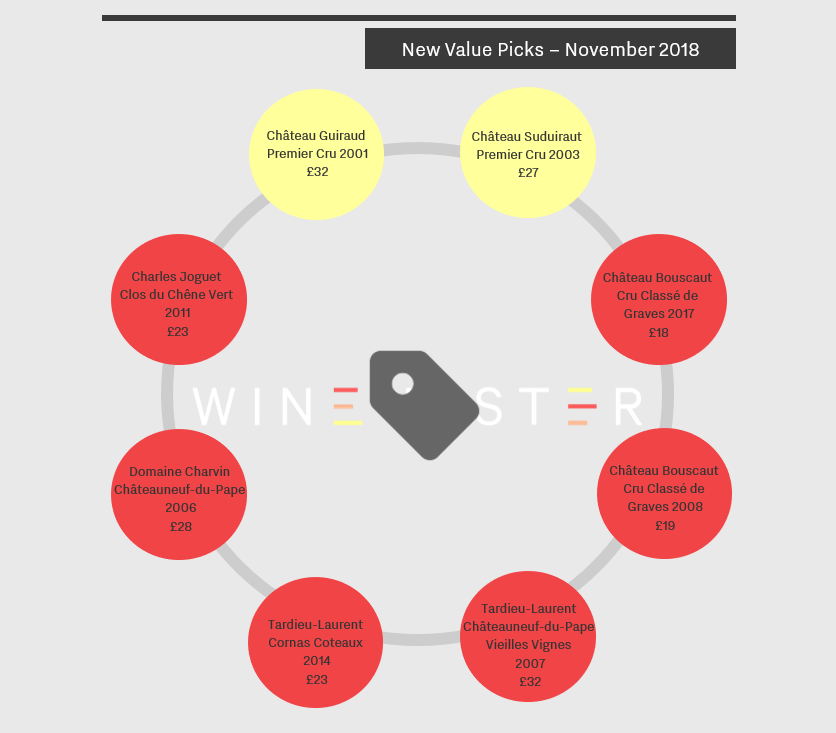
The only two whites of our new Value Picks, Château Guiraud Premier Cru 2001 and Château Suduiraut Premier Cru 2003, actually achieve the highest Quality scores of the group (936 and 929 respectively). Château Guiraud 2001 is priced at £32 per bottle in-bond, and Château Suduiraut 2003 at £27. Sadly, the incredible Quality scores of these Sauternes (as well as others across the board) may be hindered by a lack of demand for the volume produced. Sauternes typically earn poor Economics scores on Wine Lister (Château Guiraud 2001 achieves an Economics score of 212, and Château Suduiraut 2003 345), perhaps due to the pace at which older vintages of these exceptional sweet wines are consumed. With Christmas just around the corner, however, there is every reason to source either of these two for good value for your buck.
Elsewhere in Bordeaux, Pessac-Léognan rules the Value Pick reds with two listings from Château Bouscaut. The 2017 is one of Bouscaut’s new Value Pick vintages, however the real appeal, with 10 years of age, is the physical 2008 vintage, which achieves a Quality score of 768 (vs. 775 for 2017) for a price just £1 above the latest release (at £19 per bottle in-bond). These two vintages join existing Value Picks of Château Bouscaut, namely the 2016, 2015, 2013, and 2004. The latter is interestingly Bouscaut’s highest-scoring vintage ever (868), and therefore provides exceptional value at £21 per bottle in-bond.
In the Rhône, producer Tardieu-Laurent has two newcomers to the Value Pick segment: Châteauneuf-du-Pape Vieilles Vignes 2007 (£32) and Cornas Coteaux 2014 (£23), with Quality scores of 906 and 813 respectively. The Châteauneuf-du-Pape Vieilles Vignes now has an impressive six Value Pick vintages, and the Cornas Coteaux four. Indeed, Tardieu-Laurent (which was recently acquired by EPI, the owner of top Brunello producer Biondi-Santi and both Piper and Charles Heidsieck) appears a good producer to choose for value, with six of the domaine’s ten wines on Wine Lister having vintages in the Value Pick segment. It is perhaps therefore surprising that its Brand scores sit mostly in the average section of Wine Lister’s 1,000-point scale or below – uncool, but with very cool price to quality ratios.
A second Châteauneuf-du-Pape, the 2006 from Domaine Charvin is the third wine from the Rhône to make it to the list, with a Quality score of 869 and available at the modest price of £28 per bottle in-bond.
These French Value Picks convince us that “old-school” wines should not be dismissed as such. With an average price of £25 per bottle in-bond, and an average Quality score of 858, these represent excellent value for money – and that will always be cool.
Having recently confirmed Chablis as the place to look for Burgundian Value Picks, this week’s Listed blog brings the price scale up a notch to look at the top five still dry white wines under £200 per bottle by Wine Lister score. Alongside one further appearance from Chablis, the selection is pleasantly diverse.
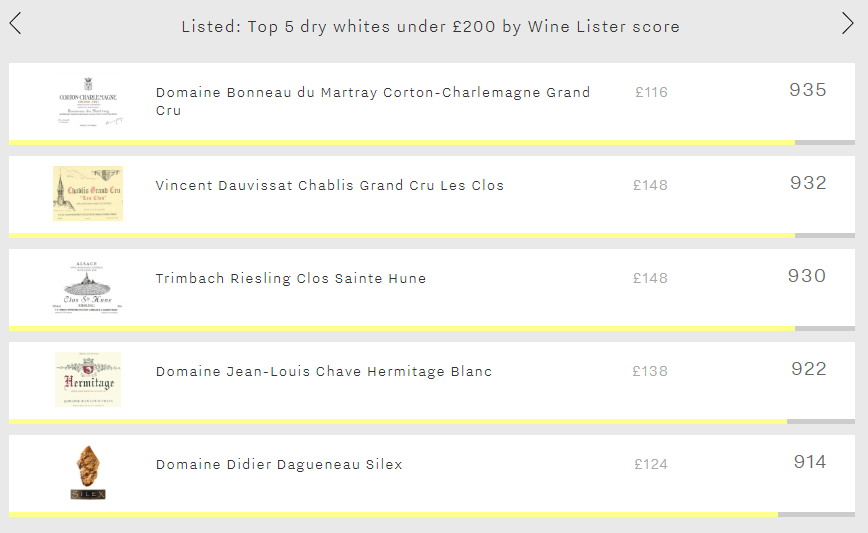
Domaine Bonneau du Martray’s Corton-Charlemagne Grand Cru takes the number one spot. With a market price of £116 per bottle, it is in fact the least expensive of the five. Brand is its strongest category with a score of 950, generated by 4,150 monthly online searches on Wine-Searcher and presence in 36 of the world’s best restaurants. Figures from Wine Market Journal also place it first for trading volumes, with 440 bottles of its top five vintages traded at auction during the last 12 months.
The second-highest scoring still dry white under £200 is Vincent Dauvissat’s Chablis Grand Cru Les Clos. It has both the highest Quality score and market price of the group (952 and £151 per bottle respectively). However, Chablis once again shows a positive price to quality ratio when compared to other white Burgundian offerings with the same Quality score. In this context, Maison Louis Jadot’s Chevalier-Montrachet Les Demoiselles and Maison Joseph Drouhin’s Montrachet Grand Cru Marquis de Laguiche are 42% and 173% more expensive (at £214 and £412 per bottle respectively).
Next on the list is Riesling Clos Sainte-Hune, Trimbach’s most iconic dry white. Its Quality and Brand scores (943 and 947 respectively) outperform its Economics score (870) resulting in an overall score of 930. Clos Sainte-Hune’s tiny production level of an average 9,600 bottles per annum (five times fewer than the 48,000 bottles of Corton-Charlemagne produced by Bonneau du Martray, for example) makes it a true rarity.
Travelling further south for the still dry white in fourth place, we find Domaine Jean-Louis Chave’s Hermitage Blanc with an overall Wine Lister score of 922. Curiously, vintage Quality score variation is more at play here than any other wine of this week’s top five. The 2016 vintage of Chave’s Hermitage Blanc earns the highest vintage Quality score of the lot (993), however 307 points separate its best from its worst vintage (2002) which is also the lowest vintage Quality score of the five.
Last but not least, the fifth highest-scoring still dry white under £200 is Domaine Didier Dageneau’s Silex, with an overall score of 914 and a market price of £124 per bottle. In a regional context, Silex takes the number one spot on all fronts with the highest Quality, Brand, and Economics scores of all Loire dry whites. As the fifth and final wine of this week’s top five, it has the highest restaurant presence with a listing in 39 of the world’s best restaurants.
Often overlooked in favour of Burgundy’s top whites, the Rhône’s counterparts should not be forgotten, particularly if you’re looking for a rich style at a more reasonable price. Whilst the Rhône’s top five dry whites for Quality can’t match the scores of Burgundy’s top chardonnays (930 vs 977), they are nearly 30 times cheaper on average (£126 vs £3564). Within the Rhône, in the battle of North vs South it is the former that comes out on top, with four expressions of Hermitage featuring in the top five.
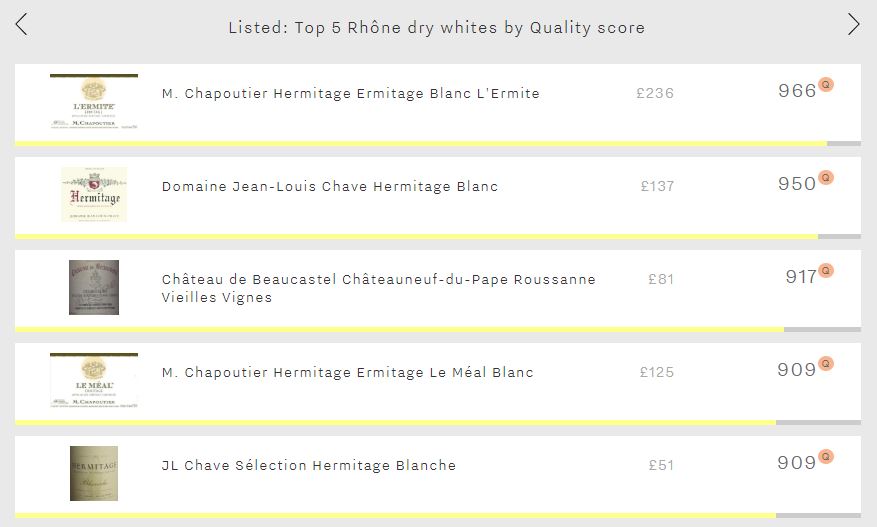
Leading the way is Chapoutier’s Ermitage Blanc L’Ermite (966). By far the most expensive of the five, it is particularly favoured by Bettane+Desseauve, the French duo awarding it an outstanding average score of 19/20. It is also the longest-lived of the group, alongside Domaine Chave’s Hermitage Blanc, with an average drinking window of 12 years. Despite its outstanding Quality score, it experiences the lowest overall Wine Lister score of the group (799), its Brand and Economics scores failing to keep pace (659 and 666 respectively).
In contrast to Chapoutier’s L’Ermite, Domaine Chave’s Hermitage backs up its excellent Quality score with the best Brand and Economics scores of any Rhône white (930 and 873), propelling it to first place in terms of overall Wine Lister score (927). It is Vinous’ favourite of the five, with an average score of 95/100, helped by a score of 97-99 for the 2015, Josh Reynolds stating that it shows “a remarkable interplay of depth, power and energy that I only occasionally encounter with the very best white Burgundies”.
Interrupting Hermitage’s hegemony is Beaucastel’s Châteauneuf-du-Pape Roussanne Vieilles Vignes (917). Proving that the appellation’s best whites can compete with their red counterparts, it outperforms Beaucastel’s straight Châteauneuf-du-Pape in the Quality category (917 vs 876). However it can’t quite beat the domaine’s flagship Hommage à Jacques Perrin (962), but at under a third of the price (£81 vs £255) it does look better value.
Two more Hermitages round out the group, another from Chapoutier – Le Méal Blanc – and, impressively, one from Chave’s négociant label – Hermitage Blanche – each with a Quality score of 909.
This week, the Listed section travels to the Rhône to consider the region’s top brands. As might be expected, all are red – Chave’s Hermitage Blanc, the region’s top white brand (924), is only the Rhône’s overall 12th strongest. However in a battle between North and South, it is the latter that comes out on top in the form of Beaucastel’s Châteauneuf-du-Pape with a Brand score of 993 – putting it amongst the top 25 brands on Wine Lister.
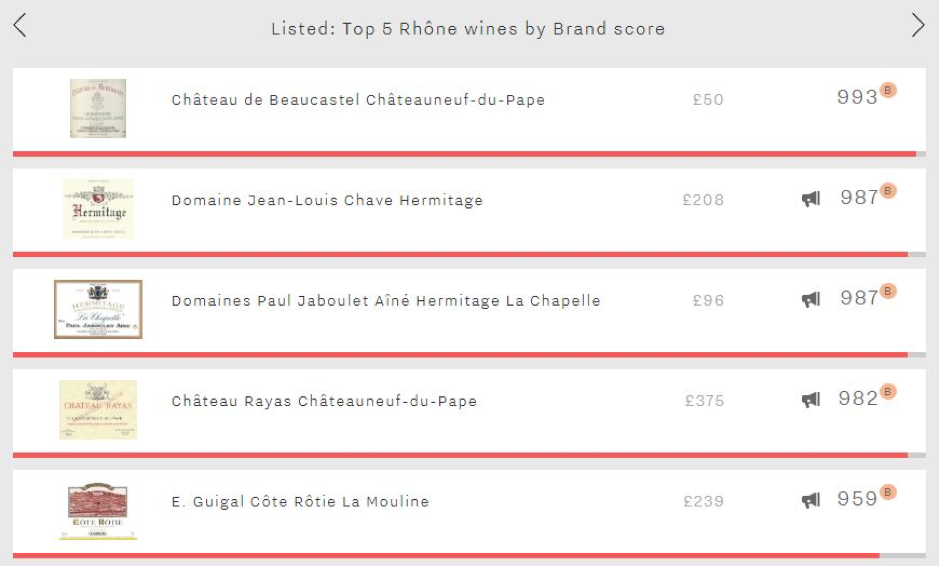
By far the cheapest of the five, Beaucastel leads across both Wine Lister Brand score criteria – presence in the world’s top restaurants and online popularity. However, whilst it is visible in 49% of the world’s finest establishments (just pipping Chave Hermitage’s 47% to the post), with 2.6 references per wine list on average it achieves the weakest vertical restaurant presence of the group, where Chave’s Hermitage manages the greatest depth (3.9 listings). If Beaucastel’s dominance within the world’s top restaurants is less clear-cut, when it comes to popularity amongst consumers it opens up a wider lead over the competition, receiving 16,565 searches on Wine-Searcher each month on average – 40% more than Jaboulet’s Hermitage La Chapelle – the group’s second-most popular wine.
Tied for second place with a Brand score of 987 are the two Hermitages from Chave and Jaboulet (La Chapelle). Whilst Chave leads in terms of restaurant presence (47% vs 43%), Jaboulet’s La Chapelle receives 6% more searches each month on average. Despite their identical Brand scores, Chave’s Hermitage is the clear winner elsewhere, with comfortable leads in the Quality category (959 vs 910) and Economics category (935 vs 863). Chave’s reward is a 36-point lead at overall Wine Lister score level (964 vs 928), and a price tag over twice that of Hermitage La Chapelle’s.
The Rhône’s overall top wine – Rayas (968) – is the region’s fourth-strongest brand (982). The group’s second Châteauneuf-du-Pape, it comprehensively outperforms the Beaucastel in terms of Quality (961 vs 876) and Economics (959 vs 823). It is thus perhaps the Beaucastel’s significantly larger annual production – roughly seven times Rayas’ – that has helped raise its brand to such lofty heights.
Rounding out the five is Guigal’s Côte Rôtie La Mouline with a score of 959. Whilst it can’t quite keep pace with the remainder of this week’s top five, it leads the two remaining “La Las” – La Landonne and La Turque – by six and 12 points respectively in the Brand category. Similarly to the Rayas, it is perhaps the extremely limited production of the “La Las” that keeps them from achieving even higher Brand scores – the combined annual output across the three cuvées is c.18,000 bottles.










